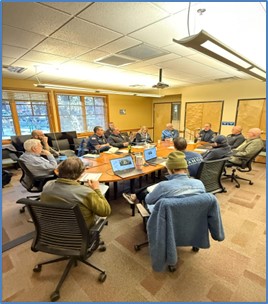Lake Tahoe Fire Chiefs Emphasize Home Hardening and Fuels Reduction to Decrease Wildfire Risk
Contact: Lake Valley Fire Protection District,
LAKE TAHOE, Calif./Nev., Feb. 11, 2025 – Lake Tahoe Basin fire chiefs and executives recently met and discussed the devastation in Southern California. These fires serve as a stark reminder of the power of wind-driven embers and their ability to ignite homes, leading to catastrophic urban conflagrations. These events underscore the urgent need to prioritize home hardening and community-wide efforts to reduce wildfire risk. CAL FIRE Amador-El Dorado Unit Assistant Chief Brian Newman, serving as the Eaton Fire Behavior Analyst, said, “The combination of strong winds and ember showers created a perfect storm, allowing fires to spread rapidly from structure to structure. Without adequate defensible space and home hardening measures in place, the risk of urban firestorms increases exponentially.”
The 21-member Tahoe Fire & Fuels Team (https://www.tahoelivingwithfire.com/about/) have made significant progress toward reducing wildfire risk and protecting Lake Tahoe communities and ecosystems. The Tahoe Fire & Fuels Team has treated more than 75,000 acres for fuel reduction since the 2007 Angora Fire, which includes pile-burning on nearly 31,000 acres to remove dead and downed material collected by hand crews. Our homes and neighborhoods are just as important. Fire professionals have conducted more than 70,000 defensible space inspections on private properties and more than 75 neighborhoods have joined the Tahoe Network of Fire Adapted Communities. Most recently, the Tahoe Fire & Fuels Team updated The Lake Tahoe Basin Community Wildfire Protection Plan (CWPP) available here at https://tahoe-basin-cwpp-trcd.hub.arcgis.com/.
Despite all of our accomplishments, Lake Tahoe’s communities and forests remain vulnerable to the threat of wildfire and there is still much work to be done. The Tahoe Fire & Fuels Team members remain steadfast in their mission to reduce wildfire risk, Basin wide. Upcoming near-term priorities for the Tahoe Fire & Fuels Team include improved fuels reduction along identified Evacuation Routes, improved fuels reduction around critical infrastructure, improved fuel breaks around communities and the establishment of strategic fuel breaks along key ridges. We are committed to implementing the National Cohesive Wildland Fire Management Strategy, which focuses on three key pillars:
- Creating Fire-Adapted Communities: By taking proactive measures to harden our homes against wildfire, such as installing ember-resistant vents, maintaining defensible space, and using fire-resistant building materials, we can significantly reduce the risk of ignition.
- Fuels Reduction: Managing vegetation through strategic thinning, prescribed fires, and defensible space projects is critical to reducing the intensity of wildfires and protecting lives, property, and our natural resources.
- Effective Fire Response: Our firefighters and first responders are highly trained and dedicated to protecting our communities, but they need your support. We aim to continue strengthening the Tahoe Water for Fire Suppression Partnership, a bi-state collaborative formed to accelerate the installation of a resilient water infrastructure to meet fire suppression needs.
While we’ve made significant strides toward reducing wildfire risk as agencies, we can’t do it ourselves. We urge every community member to get involved and support efforts to create a safer, more resilient region. Here’s how you can make a difference:
- Harden Your Home: Make improvements to your property to reduce vulnerability to ember intrusion and fire ignition. Learn more home hardening tips at www.readyforwildfire.org.
- Engage with Your Neighbors: Help those around you understand the importance of home hardening and defensible space. Engage the services of the Tahoe Resource Conservation District’s Fire Adapted Community program and your local fire agency.
- Support Fire Agencies and Land Managers: Advocate for and participate in programs that promote fuels reduction, preparedness, and fire resilience.
- Stay Informed: Follow updates from local fire agencies and participate in community workshops and preparedness events.
- Sign up for alerts: Before an emergency strikes, go to www.tahoealerts.com and register your phone to receive notifications. Prepare a Go Bag for each member of your household including pets. Ensure the Go Bag is easily accessible and filled with at least a three-day supply of items you and your family need while away from home.
Together, we can create a fire-adapted community that stands strong against the threat of wildfires. Your support is crucial to our ongoing efforts. Let’s work together to protect our homes, our families, and the beautiful region we all cherish. Learn more at www.tahoelivingwithfire.com.
###
Image caption/credit: The Lake Tahoe Regional Fire Chiefs emphasize home hardening and fuels reduction to decrease wildfire risk. Photo courtesy of Lake Tahoe Regional Fire Chiefs.
About the Tahoe Fire and Fuels Team
The Tahoe Fire and Fuels Team (TFFT) consists of representatives of Tahoe Basin fire agencies, CAL FIRE, Nevada Division of Forestry and related state agencies, University of California and Nevada Cooperative Extensions, the Tahoe Regional Planning Agency, the USDA Forest Service, conservation districts from both states, the California Tahoe Conservancy and the Lahontan Regional Water Quality Control Board. Our Mission is to protect lives, property and the environment within the Lake Tahoe Basin from wildfire by implementing prioritized fuels reduction projects and engaging the public in becoming a Fire Adapted Community.
For more information, visit Tahoe Living With Fire's "About Us" Webpage
